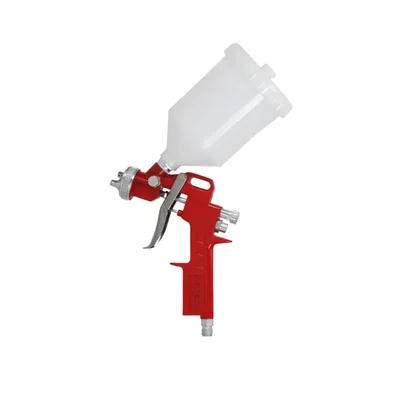- Farm & Garden
- Pumps & Motors
- Food Processing
- Workshop, DIY & MRO

Brand: Generic ( Made in India )
DG-Tech 1.5mm HVLP Spray Gun 600cc, 6.35 mm (1/4 inch) Air Inlet
SKU: TI-DH-46145 Delivery By: Dec 9 - Dec 11
Delivery By: Dec 9 - Dec 11 




MRP : ₹1450 ₹899
38% OFF!
 Delivery By: Dec 9 - Dec 11
Delivery By: Dec 9 - Dec 11 
Easy Return
& Refund
& Refund

Quality
Assurance
Assurance

Trusted
Delivery
Delivery

After Sales
Assistance
Assistance

Buyer
Protection
Protection
₹899 (Including GST)
MRP : ₹1450
38% OFF!
Get Extra ₹13 OFF on Prepaid Orders
QTY :
-
1
+
Short Description
DG-Tech HVLP Spray Gun 600cc
6.35 mm (1/4 inch) Air Inlet
1.5 mm Nozzle
Country of origin: India
Specifications
- Brand: Generic ( Made in India )
- Weight (Approx.) : 1 kg
- Nozzle : 1.5mm
- Operating Pressure : 2.0-3.0Bar
- Air Consumption : 5.0-8.0cfm
- Air Inlet : 1/4"
- Capacity : 600cc
Description
The DG-Tech HVLP Spray Gun 1.5mm 600cc is designed to deliver exceptional spraying performance for a variety of painting applications. With a 1.5mm nozzle and gravity feed system, this spray gun ensures precise control and even paint application, making it the perfect choice for professionals and DIY enthusiasts. Its lightweight design and efficient air consumption enhance usability and productivity.
Features
:- 1.5mm Nozzle Size : Optimized for spraying medium-viscosity materials like paints, clear coats, and primers with accuracy.
- Gravity Feed Design : Ensures efficient paint flow with minimal waste and easy cleaning.
- 600cc Paint Cup Capacity : Large capacity reduces frequent refilling, enabling longer spraying sessions.
- Operating Pressure : Functions efficiently at 2.0-3.0Bar for consistent spray patterns and optimal paint coverage.
- Low Air Consumption : Consumes 5.0-8.0cfm, making it compatible with most air compressors for versatile use.
- Ergonomic Construction : Lightweight and comfortable grip reduces user fatigue during extended usage.
- Universal Air Inlet : Standard 1/4" air inlet ensures compatibility with a wide range of air compressors.
Applications
:- Automotive Refinishing : Achieve a smooth, flawless finish on vehicle bodywork, panels, and accessories.
- Woodworking Projects : Perfect for applying paint, lacquer, or varnish on furniture, cabinets, and wooden surfaces.
- Industrial Coatings : Ideal for painting machinery, equipment, or metal surfaces with consistent results.
- Creative Projects : Excellent for detailed work on crafts, art pieces, and home décor items.
Usage
:Usage :
Check the Equipment :
- Ensure the spray gun, air hose, and compressor are compatible.
- Inspect all parts for damage, wear, or clogging.
Select the Right Nozzle :
- Choose the correct nozzle size for your material (paint, lacquer, etc.).
- Refer to the manufacturer's chart for viscosity vs. nozzle size.
Mix the Material :
- Properly mix and strain paint or coating to remove impurities.
- Thin the material according to the product requirements and spray gun capacity.
Fill the Cup :
- Pour the material into the gun’s cup. Do not overfill.
- Secure the lid or cap tightly to avoid spills or pressure loss.
Connect to Air Supply :
- Attach the air hose to the gun and compressor.
- Set the air pressure.
Spraying Operation
Test First :
- Spray on a test surface to adjust spray pattern, fluid flow, and fan control.
- Fine-tune air and fluid knobs for desired atomization and coverage.
Maintain Correct Distance :
- Hold the gun about 6–8 inches (15–20 cm) from the surface.
- Move the gun parallel to the surface with smooth, even strokes.
Trigger Control :
- Press the trigger in stages: air first, then material.
- Release in reverse: material off first, then air.
Overlap Strokes :
- Use 50% overlap for even coating without streaks or thin spots.
After Use – Shutdown Procedure
- Turn off the compressor and release air pressure.
- Empty any remaining paint from the cup.
- Clean the spray gun immediately after use (see cleaning below).
Daily Maintenance (After Each Use)
Disassemble & Clean :
- Remove the nozzle, needle, air cap, and cup.
- Use recommended solvents to clean internal and external parts.
- Use soft brushes or specialized spray gun cleaning kits.
Avoid Damage :
- Do not use sharp objects or metal brushes that may damage components.
- Do not soak plastic or rubber parts in aggressive solvents.
Lubricate :
- Apply a few drops of spray gun lubricant to moving parts (trigger, needle packing) to maintain smooth operation.
Weekly or Regular Maintenance
Inspect Components :
- Check seals, O-rings, and gaskets for wear or damage.
- Replace worn-out parts immediately to avoid leaks or spray inconsistencies.
Check Air Passages :
- Blow compressed air through the air channels to prevent blockages.
Test Spray Pattern :
- Ensure consistent, even spray without spitting or pulsating.
Storage Guidelines
- Store the spray gun in a protective case or clean area.
- Keep away from moisture and dust to prevent corrosion and contamination.
- Ensure all parts are dry and clean before storage.

Select attribute







